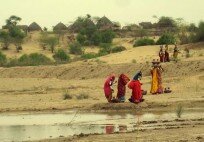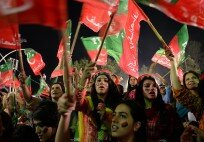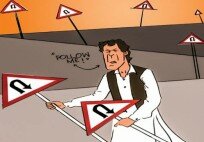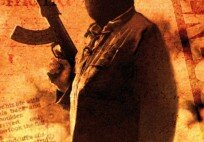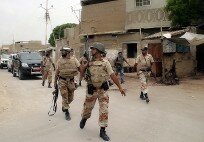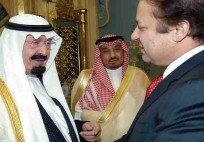By Tariq Habib –
Not exactly the safest part of town
When one stands at Cheel Chowk and observes the usual hustle bustle-filled life of Lyari, it is hard to believe that just weeks ago the area looked like a war zone and echoed with deafening sounds of gun shots and grenades’ explosions. Thousands of police and FC men headed by SSP CID Chaudhry Aslam camped at Cheel Chowk trying to enter the inner areas of Lyari to, what they said, purge the area of gangsters and criminal. But despite police’s tall claims of gaining major success against the criminals, the operation ended in utter failure and the dreaded cop of Karachi police, Ch Aslam, who has been dubbed as encounter specialist, had to eat his humble pie.
Lyari, one of the oldest neighborhoods of Karachi, has of late emerged as the biggest challenge to the PPP-led government, which has once been its stronghold for decades. Gang wars, poverty, Pakistan Peoples Party (PPP), football and boxing are the things usually associated with Lyari. But the recent police operation seems to have yielded nothing except depriving the PPP of one of its strongest support bases in Sindh as today the residents of the area are not even ready to hear the name of PPP.
Lyari has a history of gang wars, clashes between drug pushers, and clashes between criminal groups. Today, one of the oldest areas of the city is facing a war of turf by the ruling party and its allies. Major political parties of the city and mafias eye Lyari as 75 percent of the total revenue the city is contributing to the national kitty is being generated from the areas surrounding Lyari. The recent conflict and clashes between the PAC and other Karachi-based parties calming to be the biggest stakeholder of the city stem from such a huge potential of areas surrounding Lyari. These areas are considered hot cakes for political groups and mafias indulged inbhatta (extortion) collection. Every group tries to further and cement its influence over the areas and want to be the sole operator.
“Lyari has a history of gang wars, clashes between drug pushers, and clashes between criminal groups. Today, one of the oldest areas of the city is facing a war of turf by the ruling party and its allies. Major political parties of the city and mafias eye Lyari as 75 percent of the total revenue the city is contributing to the national kitty is being generated from the areas surrounding Lyari”
According to sources, the recent inter-party dispute in Peoples Party that led to the latest police action in Lyari started in early 2012 when Owais Muzaffar alias Tappi, a close relative of president of Pakistan and said to be the de facto chief minister of Sindh, and Uzair Baloch, head of banned Lyari Amman Committee (LAC) developed serious difference. Owais Muzafar alias Tappi wanted to contest the next general elections from Lyari and Uzair has also of late developed political ambitions and wanted to jump into electoral politics, which led them to be at draggers drawn. Tappi wanted the PAC to dance to his tune and wanted a say in all the major decision concerning Lyari, but the PAC leaders seemed to be no more interested in acting as a puppet of the PPP leadership.
To understand the issue, we will have to know the history of Lyari. Lyari is one the oldest areas of the city overwhelmingly dominated by Baloch population and has been a stronghold of PPP since its inception. The history of Lyari’s criminal groups started with the emergence of two groups in the area in late 1970s. Initially, the criminal groups, one headed by Shair Muhammad alias Sharo while the other by Daad Muhammad alias Daadal, were comprised mainly of unemployed youth and indulged in street crimes such as handbag snatching and other minor criminal activities.
 In 1980s, the groups started pushing drugs owing to high returns in this illegal business. Initially, both groups divided the area and carried out their operations. But conflicts between the groups emerged when they tried to further their influence by encroaching each other’s areas. At that time the members of the groups were equipped with daggers and knives only and their fight seldom resulted in loss of lives. Tensions between the groups intensified when a person, Haji Laalo, joined the group of Daadal and became his right hand man. The notorious character of Lyari gang war, Abdul Rehman alias Dacoit, was the son of Daadal. Daadal died when Abdul Rehman was only 10 years old. Haji Laloo looked after Abdul Rehman and trained him as his lieutenant. Abdul Rehman ran his group under the supervision of Haji Laloo and took control of different areas of his rivals.
In 1980s, the groups started pushing drugs owing to high returns in this illegal business. Initially, both groups divided the area and carried out their operations. But conflicts between the groups emerged when they tried to further their influence by encroaching each other’s areas. At that time the members of the groups were equipped with daggers and knives only and their fight seldom resulted in loss of lives. Tensions between the groups intensified when a person, Haji Laalo, joined the group of Daadal and became his right hand man. The notorious character of Lyari gang war, Abdul Rehman alias Dacoit, was the son of Daadal. Daadal died when Abdul Rehman was only 10 years old. Haji Laloo looked after Abdul Rehman and trained him as his lieutenant. Abdul Rehman ran his group under the supervision of Haji Laloo and took control of different areas of his rivals.
Several other minor groups emerged in mid-1980s, including Muhammad Iqbal alias Baboo Dacoit group, Aslam alias Qabarstani group, Badshah Khan group and Bhaboo alias Kala Nag group.
All these groups were fighting with each other over drug business and were being supported and patronised by influential political personalities of the area. The situation remained unchanged till mid-1990s when Abul Rehman along with his partner Yasir Arafaat (son of Haji Laloo) was arrested in 1998. Yasir Arafaat was bailed out by a court the same year because of efforts of his father Haji Lallo.
When Arafat was released on bail and Abdul Rehman was left languishing behind the bars, he got annoyed. In the same year, Abdul Rehman escaped from the court and joined the group again, but the rift between Abdul Rehman and Haji Laloo had already emerged. Consequently, Laloo joined rival group of Baboo Dacoit and started working against Abdul Rehman’s group.
There was no concept of kidnapping for ransom in Lyari till then, but the same was taking place in other parts of the city as it was witnessing ethnic bloodshed since late 1980s. At that time, a strong organisational structure was set up in Lyari to generate funds through kidnapping for ransom which expanded its operation to Balochistan and other cities of Sindh. A man named Mashooq Barohi was leading the gang of kidnappers in Sindh and was considered as the right hand of Haji Laloo.
On the other hand, the members of Balochistan Liberation Army made their way into Lyari and started their activities. During this period huge cache of weapons was smuggled and dumped in the area. The criminal elements also started looting and even attacked NATO containers more recently.
After Laloo, Abdul Rehman restructured his group and declared Noor Muhammad alias Baba Laadla as his right hand. While the son of Haji Laloo, Arshad alias Papoo started running a parallel group, which was considered main rival of Abdul Rehman Dakait’s groups.
Faiz Muhammad alias Mama Faizo (father of Uzair Jan Baloch, head of banned Lyari Amman Committee) was killed in 2003. Abdul Rehman blamed Arshad Papoo’s group for the killing of Mama Faizo. The incident fuelled the fire and the gang war reached its peak in Lyari. More than 800 persons were killed in this war. Abdul Rehman occupied all the areas dominated by Papoo and forced them out of Lyari.
In 2004, Baboo Dackait suffered from a paralysis attack and surrendered to police at his home but police showed his surrender as an encounter. He was sent to jail but got bail the same year. Later, he was killed by the group of Abdul Rehman.
SSP Choudhry Aslam, senior police official who joined the police force in 1984 as an ASI in Sindh Reserve Police, got major exposure after he was made the Lyari Task Force chief. He and Abdul Rehman had several gun battles and often Abdul Rehman would escape. An encounter between the two took place when police carried out an operation in Abdul Rehman’s hideout known as White House in Hub area in 2005. Some police personnel including Kalakot SHO Arshad were killed and several others including SSP Aslam wounded. SSP Aslam and his team also killed Abdul Rehman’s brother Raheem alias Kana and several of Abdul Rehman’s associates including Raees, Arif alias Mama, Fahim alias Bulla, Razzak alias Commando and Sharif alias Ketchu.
After this encounter Abdul Rehman came back to Lyari and started operations from there. SSP Ch Aslam killed a farmer in a fake encounter and dubbed him as notorious dacoit Mashooq Barohi. Consequently, the SSP was arrested.
Abdul Rehman was arrested second time from Satellite Town Quetta. Sources claimed that he had been arrested by Karachi police from the house of an influential political personality of Balochistan. He was shifted to Islamabad through a special plane and was investigated by the law enforcers about his links with the separatist elements of Balochistan. He was handed over to Karachi police and remained in the custody while Bahar-ud-Din Babar, a renowned police officer and SHO Kalri police station, was his custodian.
 At the same time, Bahar-ud-Din Babar was rewarded with extra charge of SPO Kalri and also Incharge of Abdul Rehman’s cell. Once again Abdul Rehman made a successful escape from the police station and joined his group in Lyari. After his escape, several police personnel including Bahar-ud-Din Babar along with personnel of intelligence agencies remained in the custody of intelligence agencies. Sources claim that at least two personnel were court martial in this case.
At the same time, Bahar-ud-Din Babar was rewarded with extra charge of SPO Kalri and also Incharge of Abdul Rehman’s cell. Once again Abdul Rehman made a successful escape from the police station and joined his group in Lyari. After his escape, several police personnel including Bahar-ud-Din Babar along with personnel of intelligence agencies remained in the custody of intelligence agencies. Sources claim that at least two personnel were court martial in this case.
As per the reports of intelligence agencies, political parties of Karachi have militant wings which are also involved in bhatta collection. Such militant wings are also taking interests in Lyari as it is surrounded by main business zones of the city. While Karachi Port Trust, which has its international importance, is also situated in its surrounding areas. The business zone is a hot cake for bhatta mafias as they are generating billion of rupees in the form of bhatta from this zone.
Lyari is also politically important as it has two constituencies of National Assembly and three of the Provincial Assembly.
Political parties of Karachi are well aware of the importance of Lyari and have always supported criminal groups. Their militant wings ganged up with Lyari criminals. The home of renowned criminal of Lyari Haji Laloo was the election office of a Karachi based political party while Abdul Rehman was fully supporting a national political party.
When Banazir came back to Pakistan, Abdul Rehman’s group took responsibilities of her security. More than 1200 boys of Abdul Rehman’s group were with the rally equipped with heavy weapons. After a bomb blast in the rally, Abdul Rehman and his group members ensured Banazir’s security and took her to Bilawal House. More than 23 members of his group were killed in the attack. Benazir declared Lyariites and Abdul Rehman as her brothers.
In the general elections of 2008, Abdul Rehman supported PPP candidates in and around Lyari while other groups supported the political party of Karachi. Haji Laloo’s group supported MQM during this period.
After the assassination of Benazir Bhutto, PPP witnessed internal conflicts, won general elections and declared a ruling party. MNA of PPP, Nabeel Gabol and MPAs Qadir Patel and Rafique Engineer won elections with the support of Abdul Rehman.
Even though PPP and MQM formed government at the province and federal level, they were rivals in Lyari and remained in cold war on the said issue. In this tenure of the government, MQM blamed PPP for the killings in Karachi and for their support to the criminal elements of Lyari while PPP leaders blamed MQM for the killings.
Abdul Rehman started political activities in the area and also provided boom to social activities. He started Ration Card system in the area and provided help to hundreds of children in getting education. He established two hospitals, reopened three government schools and two madarssahs. Sources said that he wanted to be a political personality and was interested in taking part in the next general elections. His activities invited the ire of political representatives of the area.
The issue took a new turn in Lyari when Abdul Rehman, along with his three companions, was killed in an encounter with Karachi police in Gaddap Town area. Ch Aslam was the head of the police team that killed Rehman in the encounter. This was the first time when strong reaction was shown by residents of the area in general and PAC in particular against the PPP and its MPAs and an MNA left their homes situated in Lyari.
PPP leaders controlled the issue and conducted table talks with the new team of Abdul Rehman group. Sardar Uzair Jan Baloch was named as successor of Abdul Rehman. Uzair Baloch announced that he would make some special announcements and provide proof to media about special links of Abdul Rehman with PPP leadership. At that time, local PPP leaders from Lyari apologised to Abdul Rehman’s family and took the situation in their hands. The women family members of PPP leaders visited Abdul Rehman’s home with the Holy Book in their hands and asked for apology.
PPP once again supported Lyari Amman Committee, which was at that time working under the supervision of Uzair Baloch. Uzair was nominated as the head of Balochs in Lyari as he was not involved or nominated in any criminal case by then. In 2010, the Home Minister of Sindh Dr Zulfiqar Mirza addressed a press conference and made startling allegations against MQM for their alleged involvement in target killings in the city.
At this point another group came into existence named Kachi Rabta Committee which was reportedly being supported by MQM. A war started between the armed persons of PAC and KRC resulting in more than 100 killings in the area. KRC was working under the supervision of some builders of the city who belonged to Kachi community.
KRC collected fund from their community members and purchased huge cache of weapons from smugglers and prepared to fight against PAC.
Zulfiqar Mirza also addressed several rallies arranged by the LAC and declared members of PAC as his children. This was also a period when MQM was blaming PAC leadership for their involvement in killings and other activities in the city. Till then PPP was supporting them. Mirza also announced that he had distributed weapons in Lyari for self defence.
In January 2012, situation once again took a new turn. According to sources, a close relative of Asif Ali Zardari, Owais Muzaffar Tappi, met with the leadership of PAC and asked them to make a ground for him in Lyari, saying he was going to contest next elections from there.
PAC leadership refused to accept the demand of Mr Tappi. Reliable sources said that Tappi threatened PAC leaders of dire consequence. In February, once again the leadership of PPP contacted with LAC and tried to convince them on the issue but failed.
Sources claimed that Mr Tappi gave the task of removal of the leadership of LAC from Lyari to SSP Ch Aslam. A strategy was chalked out in this regard and Haji Laloo was released on bail from jail in February and Arshad Papoo in March, just a week before the operation started in Lyari.
Pakistan Muslim League(Nawaz) took advantage of this situation and tried to get the sympathies of the people of Lyari. It seems that they got success in their strategy as LAC leaders also gave them importance.
Haji Laloo, Arshad Papoo, Bilal Sheikh, and several other groups activated themselves again and started activities against LAC in the surrounding areas of Lyari. These groups were being supported by the ruling party and its allies, as they all wanted the removal of LAC leadership from Lyari.
The influential rivals of LAC activated KRC and all other groups against LAC and cordoned them off. Police force in the supervision of Ch Aslam took an action and conducted operation in Lyari. The armed men of LAC gave a strong resistance to police. The operation continued for more than eight days but ended without any result. Six police personnel and 32 innocent persons were killed in this operation.
Sources claimed that the fighters of LAC were armed with sophisticated weapons, like rocket launchers and hand grenades. The weapons were smuggled from Balochistan to Lyari. For the first time, they used steel bullets in the area which inflicted a lot of damage. Armoured vehicles were also badly hit by these bullets.
The sources at home department say that expenditures of more than Rs 50 million, in all manners like arms, ammunition, food and other losses, were made on this operation which resulted in nothing. Police claimed that Tehreek Taliban Pakistan and Baloch Liberation Army were also active in the area and were taking part in the fight against the police force.
The administration was also divided on the issue as rangers did not take part in the operation. Rangers were of the view that they would not be a part of a controversial operation. Operation should be conducted against all criminal groups, not just against a specific group, Rangers said.
Sources said that the LAC leader was in touch with the high officials of the administration and was in good books of law enforcement and intelligence agencies as LAC helped intelligence agencies in eliminating the activists of Balochistan Liberation Army and TTP from their area.
LAC helped in arresting the terrorists of BLA, said sources.
LAC leadership had the sympathies of law enforcement agencies by simply working against the anti-state elements. Sources claimed that the strategy, made by ruling party and its allies, of removing the leadership of LAC and replacing them with other political groups, failed in this operation.
Once again, the leadership of PPP is also in touch with the members of LAC while PML(N) representatives have also had several meetings with them.
Sources claim that the operation in Lyari was a tug of war between the political parties which killed more than 38 people. The operation was also a huge financial loss to the home department. Around 1, 27,000 bullets were fired in the operation by police which cost about 10 million rupees while the damage to armoured vehicles was worth more than 10 million rupees. An armoured vehicle worth 16 million rupees was set ablaze by the fighters in the area. The expenditures of 2.5 million rupees were also reported on the food materials for the police personnel busy in the operation.
On 22nd of May, PML(N) and nationalist organisations of Sindh took part in a rally named “Mohabat Sindh Rally” along with the leadership of LAC. The rally came under attack at Panmandi, an area near Lyari. Sources say that the rival groups of LAC attacked the rally and killed 13 passers-by, including a minor girl while 40 got bullet injuries.
Intelligence agencies then sent a report to the home department that said that this issue might prove lethal for the city as there was a chance of an increased number of terrorist attacks. Ethnic violence could also take a start in the near future so strict security measures should be taken in this regard.
Interview of Ch Aslam, SSP CID
Q – Who ordered you for the operation in Lyari?
A – We got order from our high-ups to remove the criminals from Lyari as Lyari is the main area where criminals are making their hideouts and operating strong network of mafia from this area. Police department got intelligence information about the network of the gangsters and the criminals, involved in kidnapping for ransom. We made a raid at the hideout of criminals and it was not an operation; it was simply a raid for the arrest of the gangsters. I have worked a lot in Lyari at different stages in my tenure. I killed several criminals of Lyari in encounters so I was made head of the team.
Q – Were the targets achieved?
A – We conducted raid at a hideout of gangsters and faced strong resistance as criminals were using sophisticated weapons. They were making attacks on police force with hand grenades and rockets. Attackers were also using steel bullets which made damages to our armored vehicles and killed five of our brave soldiers. My soldiers were fighting with Kalashnikovs while were receiving rockets in reaction. We changed our strategy and pulled back our personnel from the area but we will make a strong and solid effort against the criminals with full of our power and remove them from the area. We have got complete information about the gangsters so our next raid will be successful.
Q – Why police cordoned off only one side of Lyari while other three remained unchecked?
A – We worked according to our strategy and did not give any gap at anywhere during the time period. We cordoned off whole area and advanced towards our targets. We did our best and will do same in our future. I have killed dozens of gangsters when I was head of the Lyari task force. These gangsters are involved in the murder of hundreds of innocent people and nominated in hundreds of FIRs. The main criminals of the gang wars are Noor Muhammad alias Baba Ladla, Tajoo and Jheengo while illegal businesses of drugs, gambling, target killing and kidnapping for ransom are being run in the supervision of such criminals. They are smuggling sophisticated weapons and rockets in different parts of the city. Police broke their network by arresting their mainstream criminals including Rauf alias Nazim.
Q – Why did different police units and Pakistan Rangers not take part in the operation?
A – This statement is totally wrong as all police units took part in the raid against criminals and actively participated to maintain law and order situation in the area. Five of our brave soldiers from different units were martyred in the war against terror in Lyari. Brave soldiers fought bravely with the gangsters armed with sophisticated weapons. Rangers did not refuse to take part in the raid against criminals as they were on call but high-ups did not feel need of calling Rangers. This is simply confusion that the Rangers did not take part in the operation.
Q – Who is Tappi and was it a political-based operation?
A – I do not know any thing about Tappi and never met with the person of such name. This was not a political-based operation; it was just a raid against criminals. We will make another attempt in near future and will arrest or kill all those criminals, involved in anti-state activities. These gangsters are also supporting the activists of Tahreek-e-Taliban Pakistan (TTP) and Balochistan Liberation Army (BLA) in the area and providing them shelter. The TTP and BLA activists are making hideouts in the area and managing their activities in the city from Lyari. We have arrested the weapons smuggler who revealed that they were providing weapons to the activists of the BLA. Some of criminals of the TTP also told during interrogation that their several companions were working in Lyari.




















